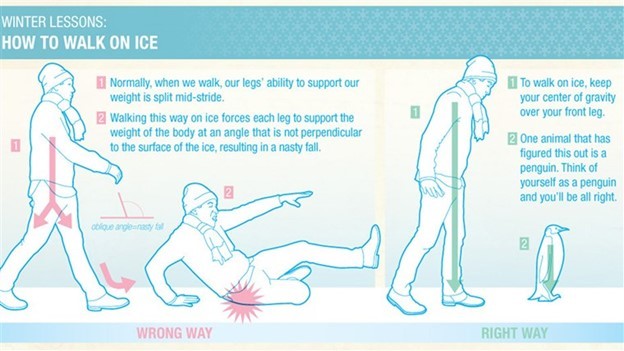Keeping outdoor walking surfaces—such as parking lots and sidewalks—clear of ice in the winter is a crucial practice at many workplaces. Not only does ice removal offer aesthetic benefits, it can also help keep you, your co-workers and the general public (e.g., customers or passersby) protected from the risk of slips and trips on the job site.
Ice Removal Best Practices
Utilize the following guidance to ensure proper ice removal procedures on the job site:
- Use the right mixture. The most effective method for de-icing an outdoor walking surface is by applying a chemical mixture throughout the area to either melt any ice that already exists or prevent ice from forming altogether. This mixture typically includes rock salt (sodium chloride), magnesium chloride pellets or calcium chloride pellets. Make sure to use the correct mixture for the conditions at hand. Add sand, about 25%, to the mixture increases friction on the surface.
- Watch the weather. Plan for what you will need ahead of time! Keep an eye on the weather forecast to determine when you need to apply the de-icing mixture to outdoor walking surfaces. This mixture should be applied when temperatures are below freezing or if conditions such as snow, hail or sleet are possible.
- Apply the mixture correctly. Make sure you apply the de-icing mixture in thin, even layers across outdoor walking surfaces. Try to apply one layer before conditions occur, one or more layers while these conditions are taking place and a final layer after conditions have passed. Keep in mind that if there is snow on a surface, it will need to be shoveled first before you can apply the de-icing mixture. Simplify the de-icing process by shoveling snow after every few inches of accumulation rather than all at once.
- Wear appropriate personal protective equipment to prevent chemical exposure. Rubber gloves, safety glasses and a face mask should be worn.
- Rock salt is most effective in temperatures above 5 degrees Fahrenheit.
- Calcium chloride pellets and magnesium chloride pellets are most effective in temperatures below 5 degrees Fahrenheit.
Winter Weather Precautions
While de-icing outdoor walking surfaces at the workplace, it’s vital to protect yourself from winter weather risks. Be sure to implement the following safety precautions during ice removal:
- Always check the weather before working outdoors to properly prepare yourself. Try to limit your time outside if weather conditions are extremely cold, wet or windy.
- Ensure you dress appropriately for the task at hand.
- Make sure you know the initial signs of health complications such as overexertion, fatigue, frostbite and hypothermia. If you start developing symptoms for these issues, stop working and inform your supervisor.
Safety First
Your safety is our priority. If you have any questions regarding workplace ice removal measures, talk to your supervisor.

- Walk like a penguin. The waddle keeps your center of gravity over your front leg and will help keep you upright. Spread your feet out slightly, to increase your center of gravity, and take small steps.
- Keep your hands out of your pockets while walking — that decreases your center of gravity and balance, according to the Centers for Disease Control and Prevention. You need your arms for balance.
- Wear shoes and boots with good traction. Avoid leather or other smooth-sole footwear.
- Walk at a slower pace.
- Stay on designated walkways.
- Use the handrail when using stairs and entering and exiting buildings and use special care when exiting and entering vehicles. Use the vehicle for support.
Sources: Zywave Safety Matters and Jim Smith Risk Manager
